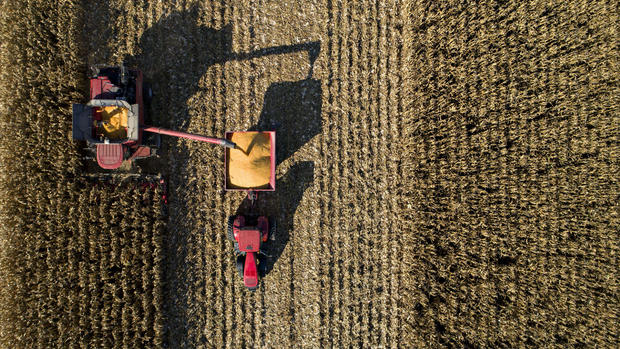What Happens if the Ethanol Bubble Pops?

An aerial photograph taken above Princeton, Illinois, U.S., on Oct. 9, 2017 shows corn being harvested. MUST CREDIT: Bloomberg photo by Daniel Acker.
I’m not sure many people in the general public realize just how much of farming today is in service of the ethanol industry.
I got to thinking about this thanks to a recent (and fascinating) article from Bloomberg about land use in the United States of America. The representation of land dedicated to ethanol caught my eye, because it’s far larger than I expected:
Here's how America uses its land https://t.co/QdrokaMfI9 pic.twitter.com/ipfMznx2gk
— Bloomberg (@business) July 31, 2018
If you click through to the article you’ll learn that land dedicated to growing ethanol and bio-diesel crops represents nearly 10 percent of all crop lands. To put that into perspective, it’s an amount of land nearly equal to the size of the entire state of Michigan. Both the upper and lower peninsulas.
This wouldn’t be particularly notable, except that demand for ethanol is very much tied up in politics.
According to the Energy Information Administration, in 2018 the United States is expected to produced 15.8 billion gallons of ethanol.
Meanwhile the federal government mandated in 2018 that American refiners blend over 19 billion gallons of ethanol into their fuels.
In other words, there is a government-created market for pretty much every gallon of ethanol produced in the United States.
But what would happen if that mandate went away?
Politicians, particularly those from far states, will fight long and hard against that ever happening, for obvious reasons. The government mandate drives up prices for ethanol crops. But recently the EPA came out with a finding that ethanol, despite being marketed for decades as a green fuel, is pretty bad for the environment:
A long-delayed report from the Environmental Protection Agency finds that requiring ethanol made from corn and soybeans to be part of the nation’s gas supply is causing serious environmental harm.
Federal law requires the EPA to assess the environmental impact of the fuel standard every three years, but the new report, issued in July, was four years overdue. According to David DeGennaro with the National Wildlife Federation, the report documents millions of acres of wildlife habitat lost to ethanol crop production, increased nutrient pollution in waterways and air emissions and side effects worse than the gasoline the ethanol is replacing.
“In finding that the Renewable Fuel Standard is having negative consequences to a whole suite of environmental indicators,” DeGennaro said, “the report is a red flag warning us that we need to reconsider the mandate’s scope and its focus on first-generation fuels made from food crops.”
President Donald Trump and senators from agricultural states are urging the EPA to allow an increase in the mandated ethanol content of gasoline.
It’s clear to honest observers that the ethanol mandate is less an environmental program than a jobs program. A government-created market for ethanol crops.
But is that market sustainable?
Ethanol is, for the most part, a product so useless the government has to make people use it. That the government does make people use it has created a massive bubble in the agriculture markets to the point where, if the government does stop the mandate, the pain felt in the agriculture industry would be acute.
This is a bubble. One created by the government. If it pops – more likely when it pops – things will be ugly.




